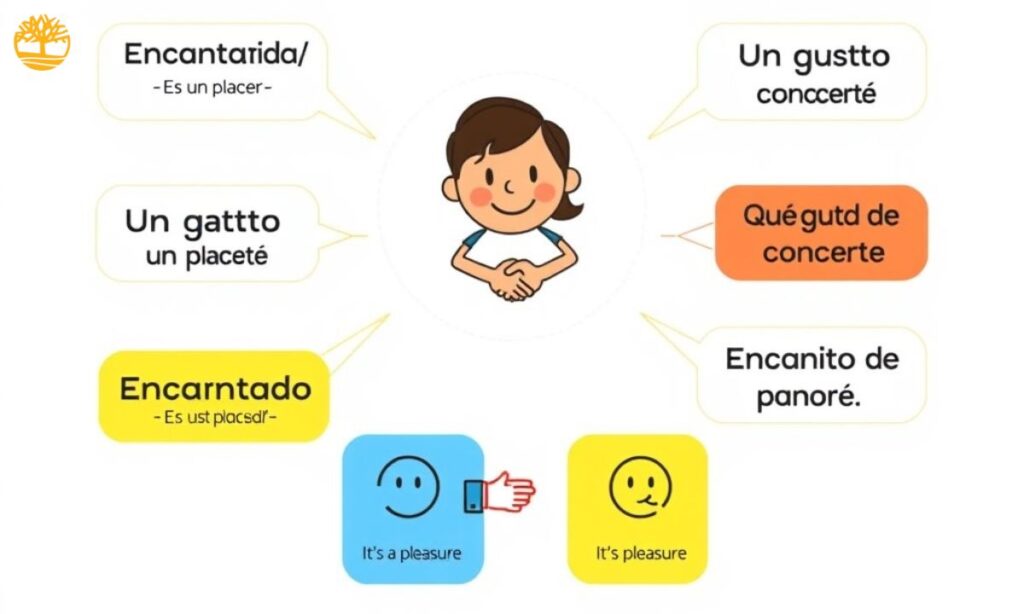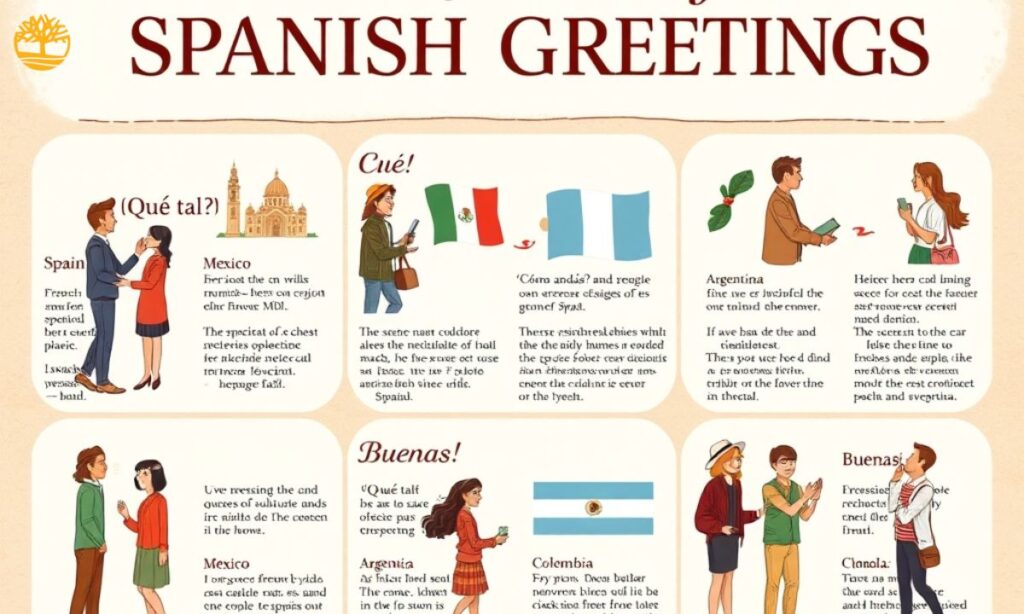¡Hola! Ever wondered how a simple Spanish greeting can open doors to heartfelt connections? “Mucho Gusto” is more than just words—it’s a warm invitation to bond across cultures. Dive into this guide to unlock its meaning and charm!
From casual chats to formal introductions, Spanish greetings carry a unique flair that varies by region and context. This guide breaks down “Mucho Gusto,” its alternatives, and the cultural nuances that make every hello special. Get ready to greet like a native and build stronger connections!
Understanding “Mucho Gusto”
Mucho Gusto is a vibrant Spanish greeting that sparks connection. It’s used widely, from casual meetups to formal introductions. This phrase carries warmth and sets the tone for friendly interactions.
Literal Translation
Mucho Gusto directly translates to “much pleasure” or “great pleasure” in English. It reflects a genuine sense of joy in meeting someone new. The phrase is simple yet conveys enthusiasm and politeness. You’ll hear it across Spanish-speaking countries with slight regional twists.
For example, when Maria meets Juan, she says, “Mucho Gusto,” with a smile, signaling her delight. In English, this might feel like saying, “It’s a pleasure to meet you.” The literal meaning keeps the greeting heartfelt and authentic. It’s a small phrase with a big impact in building rapport.
Common Usage in Everyday Conversations
Mucho Gusto shines in both casual and formal settings, making it versatile. You might hear it at a lively party or a professional handshake. It’s often paired with a warm smile or a firm handshake, amplifying its friendliness. In daily life, it’s a go-to phrase for meeting someone for the first time.
In places like Mexico or Spain, saying “Mucho Gusto” feels like second nature. It’s less about formality and more about showing genuine interest in the other person. For instance, at a café, Ana greets a new colleague with “Mucho Gusto,” instantly creating a welcoming vibe. This phrase bridges gaps, making conversations flow naturally.
Alternatives to “Mucho Gusto”
Spanish greetings offer a rich variety beyond Mucho Gusto. Phrases like Encantado or Un placer add unique flair to introductions. Each alternative carries its own tone, perfect for different settings.

Encantado / Encantada
Encantado (for men) or Encantada (for women) means “delighted” or “charmed.” It’s a warm, slightly formal way to express joy in meeting someone.
In Spain, it’s common in professional or polite settings. Use it to convey respect and enthusiasm during introductions.
Example: At a business meeting, Carlos says, “Encantado, Ana,” with a nod, showing his genuine pleasure in meeting her.
Un placer
Un placer translates to “a pleasure,” offering a refined greeting. It’s versatile for both casual and formal encounters.
You’ll hear it in settings like dinners or networking events. It conveys warmth without being overly formal.
Example: Meeting a friend’s family, Sofia smiles and says, “Un placer,” making everyone feel welcomed instantly.
Muchísimo gusto
Muchísimo gusto amplifies Mucho Gusto, meaning “greatest pleasure.” It’s enthusiastic and slightly more emphatic, perfect for lively settings.
This phrase shines in informal gatherings, like parties. It adds an extra layer of excitement to the greeting.
Example: At a festive event, Juan exclaims, “Muchísimo gusto!” to Maria, matching the vibrant mood.
El gusto es mío
El gusto es mío means “the pleasure is mine,” often a polite response. It’s a gracious way to return a greeting.
Use it to show appreciation in formal or semi-formal settings. It reflects humility and warmth in conversation.
Example: When Ana says “Mucho Gusto,” Pedro replies, “El gusto es mío,” with a courteous smile.
Es un honor
Es un honor translates to “it’s an honor,” reserved for highly respectful encounters. It’s ideal for meeting someone admired or esteemed.
This phrase is common in formal events, like ceremonies. It conveys deep respect and admiration.
Example: Meeting a renowned artist, Lucia says, “Es un honor,” expressing her genuine admiration.
Es un placer
Es un placer means “it’s a pleasure,” similar to Un placer but slightly more formal. It’s perfect for professional or polite introductions.
You’ll hear it in business or social events. It keeps the tone warm yet sophisticated.
Example: At a conference, Miguel greets a colleague with “Es un placer,” setting a professional tone.
Igualmente
Igualmente means “likewise” or “same here,” a quick, friendly response. It’s casual and works well in reciprocal greetings.
Use it in relaxed settings to mirror someone’s greeting. It’s short but conveys mutual sentiment.
Example: When Sofia says “Mucho Gusto,” Carla responds, “Igualmente,” keeping the exchange light.
Encantado de conocerte
Encantado de conocerte means “delighted to meet you,” informal and friendly. It’s great for casual, personal introductions.
This phrase is popular among younger crowds or friends. It feels warm and approachable.
Example: Meeting a new friend, Diego says, “Encantado de conocerte,” with a big grin.
Un gusto en conocerte
Un gusto en conocerte translates to “a pleasure to meet you.” It’s informal and conveys genuine friendliness.
Use it in laid-back settings, like meeting peers. It’s warm and invites connection.
Example: At a casual gathering, Elena says, “Un gusto en conocerte,” to a new acquaintance.
Es un gusto
Es un gusto means “it’s a pleasure,” a versatile and polite greeting. It works in both casual and semi-formal contexts.
It’s common in social settings across Spanish-speaking regions. The phrase feels natural and welcoming.
Example: Greeting a neighbor, Javier says, “Es un gusto,” creating an instant bond.
Con mucho gusto
Con mucho gusto means “with much pleasure,” often used to emphasize enthusiasm. It’s warm and slightly more expressive.
You’ll hear it in friendly or service-oriented contexts. It adds a touch of eagerness to the greeting.
Example: A waiter greets a customer with “Con mucho gusto,” showing warmth and hospitality.
Cultural Nuances of Spanish Greetings

Spanish greetings like Mucho Gusto carry deep cultural meaning. They vary by context, region, and non-verbal cues. Understanding these nuances builds stronger connections.
Formal vs. Informal Situations
Formal greetings like “Es un honor” suit professional or respectful settings. They show deference and are often paired with handshakes.
Informal greetings like “Encantado de conocerte” fit casual meetups. They’re relaxed, often accompanied by smiles or hugs.
Example 1: At a business conference, Maria greets her boss with “Es un placer,” maintaining professionalism.
Example 2: Meeting a friend’s sibling, Juan says, “Un gusto en conocerte,” keeping it friendly and light.
Regional Variations in Spanish-Speaking Countries
Spanish greetings vary across regions, reflecting local culture. In Mexico, Mucho Gusto is universal, but phrasing differs elsewhere.
In Argentina, “Un placer” might feel more natural in formal settings. Regional slang can also shape casual greetings.
Example 1: In Spain, Ana uses “Encantada” at a formal event, fitting the local tone.
Example 2: In Colombia, Pedro says “Qué gusto” casually, reflecting regional warmth.
Non-Verbal Gestures with Greetings
Non-verbal cues like handshakes or cheek kisses enhance Spanish greetings. They vary by region and relationship.
In Latin America, a single cheek kiss is common among friends. In Spain, two kisses are standard, even in casual settings.
Example 1: In Mexico, Sofia greets her friend with a cheek kiss and “Mucho Gusto.”
Example 2: In Spain, Carlos offers two cheek kisses while saying “Encantado.”
Exploring the Term “Hiatus” in Spanish and English
The term hiatus has unique meanings in linguistic and cultural contexts. It’s used in both Spanish and English with slight variations. This section explores its definition and practical applications.
Definition and Usage
In linguistics, hiatus refers to two adjacent vowels pronounced separately, forming distinct syllables, like in Spanish “teatro” (te-a-tro) or English “cooperate” (co-op-er-ate). In broader contexts, it means a pause or break, such as a career hiatus.
Usage varies by field, from language studies to everyday speech:
- Linguistics: Describes vowel separation in words, e.g., Spanish “poeta” (po-e-ta).
- Literature: Refers to a narrative break or gap in a story.
- Professional: Indicates a temporary pause, like a work break.
- Cultural: Can describe a pause in traditions or events.
Examples of Hiatus in Sentences
In Spanish, hiatus appears in words like “aorta” (a-or-ta), pronounced distinctly. It shapes poetry and speech rhythms in Spanish-speaking cultures.
In English, “naive” (na-ive) shows hiatus with clear vowel separation. The term also applies to breaks, like a “career hiatus” after a project.
Example 1: The Spanish word “caos” (ca-os) uses hiatus, stressing both vowels separately.
Example 2: She took a hiatus from work, saying, “I need a break to recharge.”
Conclusion
Mucho Gusto is more than a greeting; it’s a cultural bridge in Spanish-speaking worlds. Its alternatives, like Encantado, add variety and depth to interactions. Mastering these phrases enhances your ability to connect authentically.
Understanding greetings fosters stronger relationships across cultures. A well-placed “Un placer” can spark warmth and trust. Embrace these nuances to build meaningful bonds globally.

Muhammad Shoaib is a seasoned content creator with 10 years of experience specializing in Meaning and Caption blogs. He is the driving force behind ExactWordMeaning.com, where he shares insightful, clear, and engaging explanations of words, phrases, and captions.











